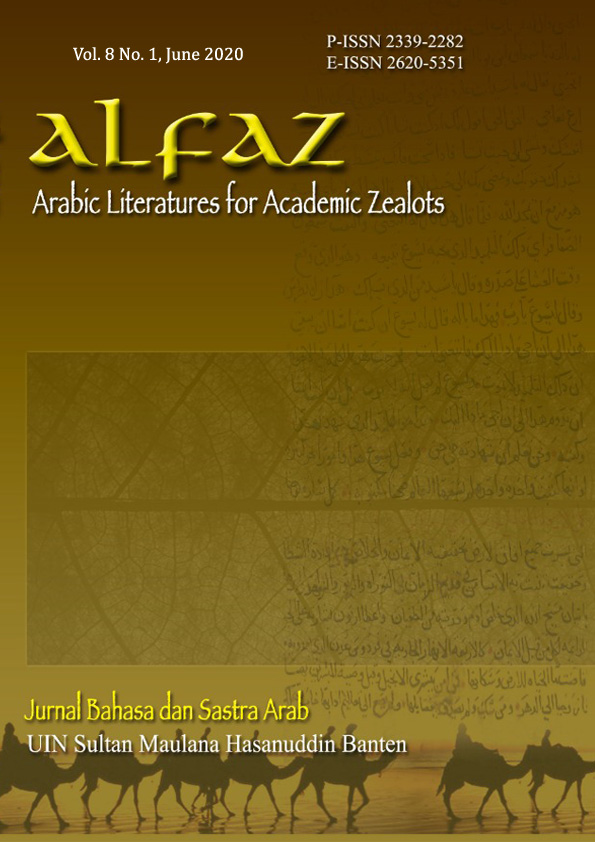Konsep at-Tajnīs menurut ʻAlī bin ʻAbdul ʻAzīz al-Jurjānī dalam al-Wasāṭah baina al-Mutanabbī wa Khuṣūmihī
DOI:
https://doi.org/10.32678/alfaz.Vol8.Iss1.2503Keywords:
Tajnīs, Jinās, ʻAlī al-Jurjānī, al-Wasāṭah baina al-Mutanabbī wa Khuṣūmihī, Literary CriticismAbstract
This article describes the concept of tajnīs in the view of ʻAlī al-Jurjānī (best known as al-Qāḍī al-Jurjānī) in his book entitled al-Wisāṭah baina al-Mutanabbī wa Khuṣūmihī. Tajnīs, later known as jinās, literally means “similar”; “resembles”; and “in the same form”. In Arabic rhetoric theories (Balāghah), jinās is a linguistic style which combines two similar words in a sentence that share the same sound with different meaning from each other. The work of al-Qāḍī al-Jurjānī is considered as a breaktrough in classical literary criticism. From the title of the book, he tried to compromise between the poet al-Mutanabbī and his opponents who argued agaist his oppinions in poetery making. There came al-Jurjānī as a mediator by proposing ideal points of view for literary criticism which lay on objective standards. Among those standards is what he called tajnīs. By employing analytical method to the data, this study finds five classifications of jinās according to al-Qāḍī al-Jurjānī. They are tajnīs muṭlaq (exact similarity), tajnīs tām or tajnīs mustawfā (complete simmilarity), tajnīs muḍāf (similar words with one word comes in compounding words), tajnīs nāqiṣ (lack similarity), and tajnīs taṣḥīf (similarity caused by misspelling). This classification was employed by al-Qāḍī al-Jurjānī for his critic to al-Mutanabbī’s potery in the level of the wording, and can be broadly applied to all Arabic literary works.
Downloads
References
Chaer, Abdul, Linguistik Umum, (Jakarta: Rineka Cipta, 2007).
Hasyimī (al-), Aḥmad, Jawāhir al-Balāghah, (Beirut: Dār al-Maʻrifah, 2009)
-----------------, al-Balāghah al-Wāḍiḥah, diterjemahkan oleh Mujiyo Nurkholis dkk, (Bandung: Sinar Baru Algensindo, 2013)
Hilāl, Aḥmad Hindāwī, al-Jinās fī Asās al-Balāghah li al-Zamakhsyarī: Dirāsah Balāghiyah Taḥlīliyyah, (Kairo: Maktabah Wahbah. 2002)
Idris, Mardjoko, Ilmu Badi’ Kajian Keindahan Berbahasa, (Yogyakarta: Karya Media, 2017)
Idris, Mardjoko, Ilmu Balaghah, Antara al-Bayan dan al-Badi’, (Yogyakarta: Penerbit Teras, 2007)
Jārim (al-), ʻAlī dan Muṣṭafā Amīn, al-Balāghah al-Wāḍiḥah. TT
Jurjānī (al-), ʻAlī bin ʻAbdul ‘Azīz, al-Wasāṭah Baina al-Mutanabbī wa Khusūmihi, ( ‘Īsā al-Bābī al-Ḥalabī: TT )
Muhsin, Wahab dan Fuad Wahab, Pokok-Pokok Ilmu Balaghah, (Bandung: Angkasa, 1986)
Thabrani (al-), Hananah Mukhtar, “Nasy’atu ‘Ilmi al-Badīʻ wa Taṭawwurihī: Mundzu al-Bidāyati ilā al-Qarni as-Sābiʻ al-Hijrī” Jurnal ALfAZ UIN Banten Vol.3 No1. (Juni 2015)
Downloads
Published
Issue
Section
License
Authors retain copyright and grant the journal right of first publication with the work simultaneously licensed under a CC BY NC SA License that allows others to share the work with an acknowledgement of the work's authorship and initial publication in this journal.







